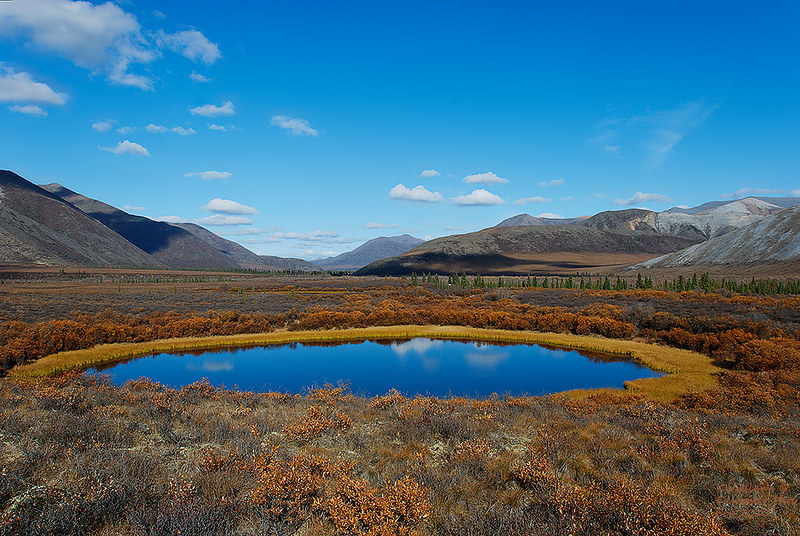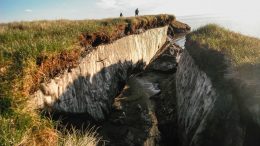Happenings in the Arctic rarely make the news unless — as we saw this May — a heatwave strikes or a wildfire erupts. Both of those increasingly common events remind us that climate change is already transforming the region — and by extension, the rest of the planet.
But there’s another process underway in the Arctic that gets less attention but poses a looming threat: thawing permafrost.
A whopping 25% of the land in the northern hemisphere is underlain by permafrost — land that’s been frozen for at least two consecutive years, although some of it’s been frozen for millennia. Scientists estimate that there’s about twice as much carbon locked away in these frozen soils as is currently contained in the atmosphere.
Our burning of fossil fuels could further warm the Arctic and unleash that stored permafrost carbon — and set the planet on a dangerous course.
There’s still a lot we don’t know about the “climate bomb” potential of melting permafrost. Christina Schädel, a biogeochemist at Northern Arizona University, believes it’s an urgent issue. She’s spent the last nine years studying permafrost carbon and its potential to exacerbate climate change.

We talked with Schädel, who also co-leads the Permafrost Collaboration Team of the Interagency Arctic Research Policy Committee, about the climate risks and whether we’ve passed a key tipping point.
How is the current level of warming affecting permafrost?
We have more than twice as much warming in the Arctic compared to the rest of the globe. And warming air also means warmer soil temperatures, so permafrost warms up as well and then it transitions from frozen to unfrozen. As it thaws, the microbes that live in permafrost wake up. They become active and start decomposing organic material that has been frozen, and that releases additional amounts of carbon dioxide and methane into the atmosphere.
What does this mean for the climate? Have we passed a tipping point?
This means more greenhouse gases and even more warming. Because the Arctic is already warming more, it creates a feedback loop that gets stronger and stronger. That’s a big issue for the global climate.
It’s something we should be worried about now, because any greenhouse gases that have been released will not go back into permafrost.
But if we stop warming now, we have a chance of keeping some of the permafrost frozen — that is the goal.
How much carbon dioxide could be released?
If current warming continues, an estimated 130-160 billion tons of permafrost carbon could be released into the atmosphere in the form of greenhouse gases during this century. By comparison, it’s less than emissions from burning fossil fuels but similar to what’s expected from deforestation. The important thing to consider is that those emissions from permafrost are on top of human-caused emissions.
When we talk about the available carbon budget that countries can emit before we hit too much warming, we should account for permafrost carbon loss as well because it’s almost like its own country. It has a certain amount of carbon that will also be released and so on a political level, it’s something that should be accounted for, but it isn’t yet.
Are certain areas more vulnerable than others to thawing?

Yes, one area is the region further south where the permafrost is already warmer. It’s hovering just below the freezing point, so the transition to unfrozen can happen very quickly.
The other areas that are vulnerable are those that have a lot of ice in them. If the ice melts, then you have the disruption of the soil structure. That exposes the soil to much warmer temperatures from the air, and that can enhance microbial decomposition.
So it’s not just the southern edges of permafrost that are vulnerable, it’s also the far North locations. If a wildfire happens, for example, that can cause permafrost to thaw because the insulating layer of mosses will burn away, and then much warmer temperatures will penetrate the soil.
And it’s not just carbon dioxide, but also methane that’s a potential risk, right?
Yes, methane is definitely a concern, too. It’s another greenhouse gas with a higher global warming potential [in the short term] than CO2.
We have a hard time so far identifying exactly where methane versus carbon dioxide is going to be released, because it depends on the wetness of the soil. Under anaerobic conditions you have methane, and under aerobic conditions you have mostly carbon dioxide. Some permafrost contains a lot of ice. Other profiles contain much less ice. So it’s unclear which areas will become wetter and which ones will become drier, and that will influence the ratio of carbon dioxide to methane that’s released when the permafrost thaws.
What else are researchers still learning about permafrost and climate change, and why does that work matter when the world faces so many other climate threats?
We’d like to get better at identifying carbon stocks — how much carbon there is in the permafrost. We have a pretty good idea, but it’s such a vast area. And then we would really like to improve models that predict permafrost carbon loss and permafrost extent loss.
In addition, better quantifying abrupt versus gradual thaw is considered important and timely. Gradual thaw is mostly a top-down thaw, and abrupt thaw occurs more sporadically in places where ground ice is abundant. When it melts the ground collapses because there is empty space where the ice used to be.
What happens in the Arctic is so important because greenhouse gases mix really well [throughout the atmosphere]. So even if they are released in the far North, they can be measured here in Arizona where I live.
More greenhouse gases being released means more warming. It doesn’t matter where. We all share the same atmosphere.
![]()


